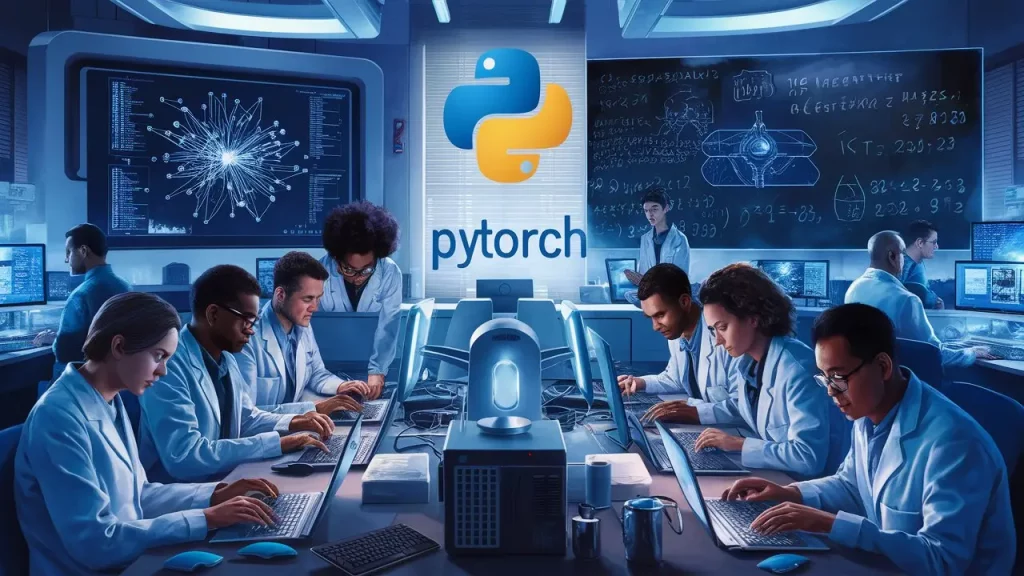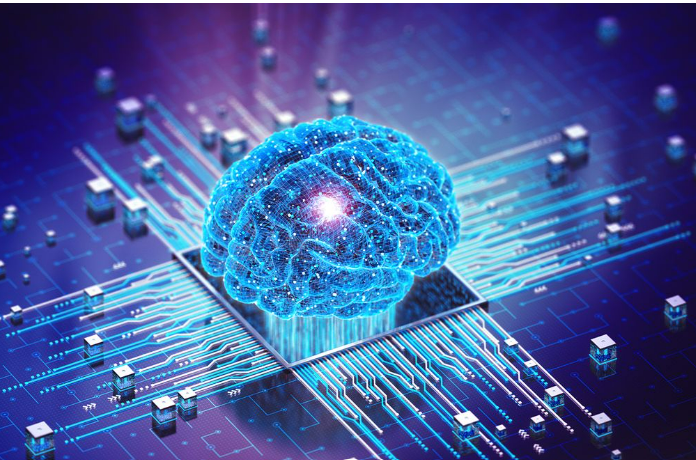In machine learning, deep learning is a branch that uses artificial neural networks to imitate the functions of a human brain. It processes unstructured data sets and makes decisions using these artificial neural networks. Indeed, PyTorch is an important framework in deep learning that holds substantial significance for researchers and developers. This blog explains what is PyTorch, its features, core functionalities, advantages, and the resources available to learn it.

What is PyTorch?
PyTorch is a Machine Learning Framework based on Python. It’s open source and extends the functionalities of the Torch library. Torch is a free machine learning library employed to create complex neural networks. It is developed using the Lua programming language.
PyTorch framework handles over 200 different mathematical operations without any issues. Undoubtedly, it’s becoming increasingly popular because of its capability to simplify the creation of artificial neural network models. Especially, it’s used for applications and research in artificial intelligence by data scientists.
Initially, PyTorch was an internship project of Adam Paszke while studying under Soumith Chintala, a core developer of Torch. Paszke collaborated with developers from various universities and companies and conducted testing on PyTorch.
Features of PyTorch
One important feature of PyTorch that sets it apart from other machine learning libraries is its dynamic nature of computational graphs. It builds the computational graphs spontaneously during the code execution. Subsequently, this dynamic approach offers several advantages:
- Flexibility: The neural network architecture is easily defined and modified even during the runtime. Further, this allows for greater experimentation and rapid prototyping.
- Debuggability: Since the graph is built incrementally, you can easily debug your code line-by-line, pinpointing errors much faster.
- Imperative Programming: PyTorch uses the imperative programming style of Python. Hence, the code is more readable and intuitive for those familiar with the Python syntax.
Core Functionalities of PyTorch
PyTorch offers some exceptional functionalities to empower Deep Learning projects. Some of the key functionalities are the following:
Tensors
Tensors are n-dimensional arrays similar to NumPy arrays but with GPU acceleration capabilities. It’s a powerful tool of PyTorch. Certainly, tensors form the foundation of deep learning models, representing data like images, text, or numerical values.
Automatic Differentiation
A crucial aspect of training neural networks is calculating gradients and PyTorch does it by automatic differentiation. It is done through either forward mode or reverse mode. Automatic differentiation allows you to optimize the network’s weights and biases efficiently for better performance.
Loss Functions
A loss function evaluates if the algorithm has represented the data set well. PyTorch provides various built-in loss functions. Some widely used loss functions are
- the mean squared error loss,
- the cross-entropy loss,
- the Huber loss,
- the hinge loss.
Additionally, a user can also create custom loss functions in PyTorch.
Optimizers
PyTorch optimizers are algorithms that modify the weights and biases of the neural network based on the calculated gradients and the chosen loss function. They improve the performance of the deep learning algorithm by fine-tuning them during the training. Also, they minimize the difference between the predicted output and the actual output by adjusting the parameters. PyTorch offers a range of optimizers like
- Stochastic gradient descent
- RMSprop
- Adagrad
- Adadelta
- Adam
Applications of PyTorch
The easy use of PyTorch offers a wide range of deep learning applications. Here are some well-known examples:
1. Computer Vision
Computer vision means to enable the computer to visualize. In particular, it refers to gathering and processing data from visuals. PyTorch is an effective tool for developing Computer Vision applications. Specifically, it helps with applications like
- image classification,
- object detection,
- image segmentation,
- pose estimation.

2. Natural Language Processing
Natural language processing gives endless possibilities in deep learning. PyTorch is the best framework for tasks like text classification, sentiment analysis, machine translation, and text summarization. In addition, libraries like Torchtext provide functionalities for text processing and loading pre-trained language models.
3. Recommender Systems
Recommended systems have evolved a lot by deep learning. The feature power suggestion is used on various platforms among the recommender systems. Indeed, PyTorch builds these systems by analyzing user behaviors and recommending relevant items or content.
4. Reinforcement Learning
Reinforcement learning algorithms learn through trial-and-error methods in interactive environments. It learns from the feedback of each action to give the optimal results. PyTorch framework is used for the implementation of reinforcement learning algorithms. Apart from making the trial-and-error process easier, with its tensor operations and GPU acceleration, it’s also faster.
Advantages of Using PyTorch
PyTorch is the most popular framework for developing deep learning applications. Following are some of the advantages of using PyTorch:
- PyTorch framework is very user-friendly. Both beginners and advanced developers find PyTorch easily accessible due to the easy Python syntax and the dynamic computational graphs.
- Its dynamic approach offers a significant advantage while trying various architectures and troubleshooting codes. Thereby, making it very flexible.
- PyTorch has a strong community and resources, supported by Facebook. In addition to the online forums available for support and learning, these resources offer plenty of documentation and tutorials.
- The PyTorch framework is consistently progressing. Furthermore, it improvises with regular additions of new features and enhancements.
PyTorch Versus TensorFlow
PyTorch and TensorFlow are both robust open-source frameworks. In this section, let’s analyze how they stack up against each other. PyTorch is beginner-friendly, especially, for those familiar with Python due to its adherence to object-oriented programming principles. The dynamic computational graphs give the flexibility to alter things on the go. It’s preferred in research and prototyping because of its ease of use and flexibility.
In contrast to PyTorch, with its static computational graphs, TensorFlow demands proper and structured planning. Comparatively, it’s a difficult framework to learn for beginners. Also, it’s more efficient for large-scale projects in production. Hence, it’s more preferred in business for its robustness and scalability. Although both frameworks have good communities and resources, TensorFlow has a slight edge as it’s older.
Learn More with Henry Harvin
The official website of PyTorch has commendable resources. It provides comprehensive documentation, tutorials, and examples to learn PyTorch. Additionally, you can read books on PyTorch. Books offer a structured learning path for both beginners and experienced programmers.
Online courses and tutorials specifically designed for learning PyTorch are also good options. For a valuable online course on PyTorch, check out the Artificial Intelligence Course by Henry Harvin. Professionals with extensive industry experience meticulously design the coursework. Also, the coursework involves more practical content to enable the students to become more competent. In addition, they provide a range of artificial intelligence and machine learning courses. From Natural Language Processing Course to Metaverse Professional Course, they have a wide range of artificial intelligence courses.
Conclusion
Artificial intelligence has evolved into a critical tool in all fields. Indeed, companies look forward to using artificial intelligence to achieve their objectives and scale up their business. PyTorch is a powerful deep-learning framework in artificial intelligence. PyTorch’s dynamic nature of computational graphs sets it apart from other libraries. It not only possesses a wide range of tutorials and documentation but also is well-known for its user-friendliness, flexibility, and constant innovation. Subsequently, this makes PyTorch a valuable skill to possess.
FAQs
PyTorch is mainly used for applications and research in artificial intelligence by data scientists. It can handle over 200 different mathematical operations without any issues. Moreover, it simplifies the creation of artificial neural network models.
A stand-out feature of PyTorch is its dynamic nature of computational graphs. It builds the computational graphs spontaneously during the code execution.
The pros of PyTorch are:
1. it user-friendliness,
2. its flexibility,
3. the availability of resources, and
4. its constant innovation.
Some applications of PyTorch are:
1. Computer vision
2. Natural language processing
3. Recommender systems
4. Reinforcement learning
PyTorch is an easy-to-learn framework. Especially if you are familiar with the Python language, then PyTorch is much simpler to follow. Also, it’s the most commonly used deep learning framework. Hence, if you look forward to working in the deep learning domain, then PyTorch is a valuable skill to add to your profile.



